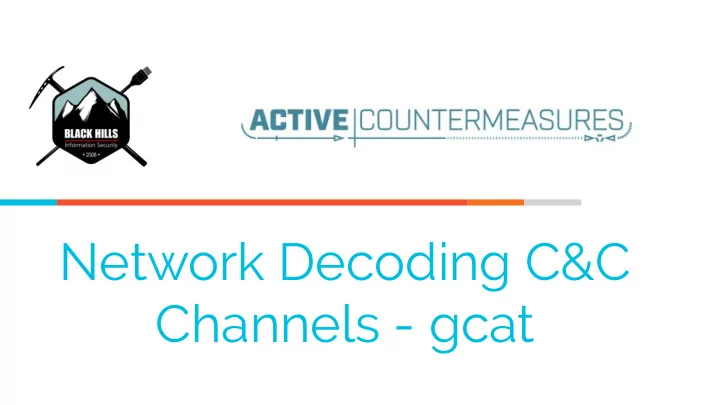

Network Decoding C&C Channels - gcat
Brought to you by... + = Red Team/Blue Team Awesomeness
This will be a series! ▷ Positive response to decoding dnscat2 ▷ We've decided to make this a series ▷ Will dissect a C&C every few weeks ▷ Hit us up on Twitter if there is a C&C you want covered ○ @activecmeasures
What we will cover ▷ Deep dive on gcat ▷ Interesting in that many vendors ignore it ▷ We will show ○ What it looks like on the wire ○ Various methods of detection Some scale easier than others ■ ▷ Lab format so you can play along ○ Will make slides and Zeek logs available
gcat ▷ Pretty simplistic C&C ○ But oh so hard to detect ▷ Basically, a Python based email client ▷ Communicates to GMail via IMAP4/TLS ○ Could easily be adapted to other mail services ○ Would not be that hard to adapt to other protocols ▷ Checks for email in an account you define ▷ Received email checked for commands
Some basic protections ▷ Uses IMAP4 over TLS ○ TCP/993 to check for commands ○ TCP/587 (SMTP/TLS) to send responses ○ Both can obviously be changed ▷ Can you lock this down? ○ Is there a business need for this traffic? ○ If not, close all remote email client traffic ○ Problematic if they switch to HTTPS ▷ The above applies to all public mail servers
Why is gcat hard to detect? Time gap between sessions gcat uses the same signal timing as a regular email client
Let's work with Zeek (Bro)!
Absolute time only 24-hours of data
Other options ▷ tshark will print time deltas ▷ Time deltas let us analyze beacon timing ○ Need to look at the time gap between signals ▷ Zeek will only give us absolute time ○ In conn.log, other log formats support ts_delta ○ Doesn't matter - C&C and email use same timing ▷ Other options ○ What if we wanted to work with time deltas? ○ What other data can be analyzed for beacons?
Works but does not scale
gcat - Focus on packets and bytes
Consistency in packet quantity
Consistency in data transferred
Let’s look at it with RITA ▷ Open source tool supported by ACM ▷ Designed to identify C&C channels ▷ Command line based, but powerful ▷ Will identify ○ Beacons ○ Long connections ○ Suspect DNS ○ Blacklist communications ○ Plus a whole lot more
What RITA detected 87.4% certain this is a beacon Usually > 90% is actionable
Reminder of why this is hard Plot of session activity over 24 hours Could be an email client or gcat, both use the same timing.
Session size analysis of user email Average is send/receive 130 emails per day
Well this looks odd...
gcat once it's activated
User email versus gcat ▷ Similar session timing used for both ▷ User email ○ Expect to see lots of unique session sizes ○ 130 emails per day is the industry average ▷ gcat ○ One very strong signal for heartbeat ○ Some small number of other sizes ○ Once each time gcat is activated
What have we learned? ▷ gcat cannot be detected based on timing ○ Mimics normal email clients too closely ○ This is why many tools ignore this channel ▷ gcat can be detected through other means ○ Packet quantity ○ Session size comparison ▷ Tag by understanding "normal" and identifying deviations
Wrap up / Q&A ▷ Drop a tweet to @activecmeasures and tell us what C&C channel to cover next ○ https://twitter.com/ActiveCmeasures ▷ Type “demo” in the chat if you would like a demo of AI-Hunter ▷ To grab RITA: http://acm.re/free-tools/rita/ ▷ To grab the pcaps from this webcast: http://acm.re/webcast-file-downloads/
Recommend
More recommend